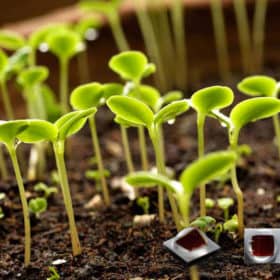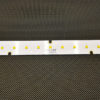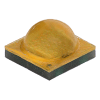Horticulture Design
What is PPFD and DLI
Photosynthetic Photon Flux Density (PPFD) and Daily Light Integral (DLI) are essential measurements in horticulture, as they provide information about the quantity and quality of light that plants receive for photosynthesis. Photosynthesis is the process by which plants convert light, carbon dioxide, and water into glucose, which provides energy for growth and development. Understanding PPFD and DLI is crucial for optimising plant growth in both natural and controlled environments.
PPFD is a measure of the number of photons in the photosynthetically active radiation (PAR) range (400-700 nm) that reach a given surface per unit time, expressed in micromoles of photons per square meter per second (µmol/m²/s) [1]. DLI, on the other hand, is a cumulative measure of the total amount of PAR received by a plant in a 24-hour period, expressed in moles of photons per square meter per day (mol/m²/d) [2]. DLI is calculated by integrating PPFD measurements over a day.
Lux is a unit that quantifies the intensity of light as perceived by the human eye, and it is weighted towards the green part of the spectrum. While Lux can give an approximate indication of light levels, it does not accurately represent the light energy available for photosynthesis [3]. To convert Lux to PPFD, you can use the following equation [4]:
PPFD (µmol/m²/s) = Lux × Conversion Factor
The conversion factor varies depending on the light source’s spectral distribution. For instance, the conversion factor for sunlight is approximately 0.0185 [4]. However, it is important to note that this conversion may not be accurate for all light sources, especially those with narrow-band spectra, like LED grow lights.
Understanding a light source’s spectral distribution is essential when converting lux to PPFD, as it allows for a more accurate representation of the light energy available for photosynthesis. Spectral distribution refers to the intensity of light emitted at different wavelengths across the electromagnetic spectrum. As photosynthetically active radiation (PAR) includes wavelengths between 400-700 nm, the spectral distribution of a light source directly impacts the conversion factor used to convert lux to PPFD.
To calculate the conversion factor, you need to have the spectral power distribution (SPD) of the light source. The SPD is a graphical representation of the emitted light’s power across the spectrum, measured in watts per nanometer (W/nm).
Here’s a step-by-step guide to calculating the conversion factor for a light source:
- Obtain the SPD: Obtain the spectral power distribution of the light source from the manufacturer’s data or by using a spectro-radiometer, a device that measures the power emitted at different wavelengths.
- Calculate the spectral weighting function: Determine the spectral weighting function, which is the relative response of the plant’s photosynthetic apparatus to light of different wavelengths. McCree’s action spectrum, derived from research on crop plants, is commonly used for this purpose [1]. The action spectrum has values ranging from 0 to 1 for wavelengths between 400-700 nm.
- Calculate the conversion factor: Multiply the SPD values by the corresponding action spectrum values for each wavelength within the PAR range. Then, sum these products and divide by the sum of the SPD values for the same wavelengths. This ratio represents the conversion factor:
Conversion Factor = (Σ(SPD × Action Spectrum)) / Σ(SPD)
- Convert lux to PPFD: To convert lux to PPFD, multiply the lux measurement by the calculated conversion factor:
PPFD (µmol/m²/s) = Lux × Conversion Factor
Keep in mind that this conversion method may not be accurate for all light sources, particularly those with narrow-band spectra, like LED grow lights. It is recommended to use a quantum sensor or PAR sensor to directly measure PPFD for greater accuracy.
Example:
Let’s consider an example of a light source with a simplified SPD data:
| Wavelength (nm) | SPD (W/nm) | Action Spectrum |
|---|---|---|
| 400 | 0.10 | 0.15 |
| 500 | 0.25 | 0.90 |
| 600 | 0.30 | 0.75 |
| 700 | 0.15 | 0.10 |
Calculate the conversion factor:
- (0.10 × 0.15) + (0.25 × 0.90) + (0.30 × 0.75) + (0.15 × 0.10) = 0.015 + 0.225 + 0.225 + 0.015 = 0.480
- Σ(SPD) = 0.10 + 0.25 + 0.30 + 0.15 = 0.80
- Conversion Factor = 0.480 / 0.80 = 0.60
If the lux measurement for this light source is 1000 lux, the PPFD value can be calculated as follows:
PPFD (µmol/m²/s) = 1000 Lux × 0.60 = 600 µmol/m²/s
In summary, understanding the spectral distribution of a light source and calculating the conversion factor is crucial when converting lux to PPFD. This allows for a more accurate assessment of the light energy available for photosynthesis, ultimately helping optimise plant growth and productivity.
Daily Light Integral (DLI) is a measure of the cumulative amount of photosynthetically active radiation (PAR) that plants receive during a 24-hour period. It is expressed in moles of photons per square meter per day (mol/m²/d). DLI is an essential metric in horticulture because it helps growers determine the total light energy available for photosynthesis, which directly impacts plant growth, health, and productivity. Different plant species and growth stages have varying DLI requirements, making it important to provide the right DLI level to optimize growth.
Calculating DLI:
DLI can be calculated by integrating Photosynthetic Photon Flux Density (PPFD) measurements taken at regular intervals throughout the day. The general formula for calculating DLI is:
DLI (mol/m²/d) = (ΣPPFD) × (Time Interval) × (Conversion Factor)
Where:
- ΣPPFD is the sum of the PPFD measurements taken during the day
- Time Interval is the duration (in seconds) between each PPFD measurement
- Conversion Factor is used to convert the units from µmol/m²/s to mol/m²/d (1 µmol = 10⁻⁶ mol, and 1 day = 86400 seconds, so the conversion factor is 10⁻⁶ × 86400 = 0.0864)
Here are two examples of how to calculate DLI:
Example 1 – Constant PPFD:
In a controlled environment like an indoor grow room, the PPFD might remain constant throughout the photoperiod (the period when the lights are on). Let’s say you have a PPFD of 600 µmol/m²/s, and the lights are on for 16 hours (57600 seconds).
DLI (mol/m²/d) = (600 µmol/m²/s) × (57600 s) × (0.0864) DLI = 2985.6 mol/m²/d
Example 2 – Variable PPFD:
In natural environments, the PPFD will vary throughout the day. In this example, let’s consider you have taken PPFD measurements every hour for a total of 12 hours:
| Time (h) | PPFD (µmol/m²/s) |
|---|---|
| 1 | 100 |
| 2 | 200 |
| 3 | 400 |
| 4 | 600 |
| 5 | 800 |
| 6 | 900 |
| 7 | 900 |
| 8 | 800 |
| 9 | 600 |
| 10 | 400 |
| 11 | 200 |
| 12 | 100 |
First, sum the PPFD values: ΣPPFD = 5100 µmol/m²/s
Assuming the time interval between each measurement is one hour (3600 seconds):
DLI (mol/m²/d) = (5100 µmol/m²/s) × (3600 s) × (0.0864) DLI = 15.9 mol/m²/d
Monitoring and adjusting DLI based on the specific needs of the plants is crucial for optimizing growth and productivity. By calculating DLI, growers can ensure their plants receive the appropriate light levels and make necessary adjustments to lighting, shade, or photoperiod as needed.
There are several resources available to help determine the appropriate PPFD and DLI values for different plant species and growth stages:
- Purdue University Extension provides a comprehensive list of DLI requirements for various plant species [5].
- Michigan State University Extension offers guidance on determining the optimal PPFD and DLI values for various greenhouse crops [6].
By monitoring and adjusting PPFD and DLI, growers can ensure their plants receive the appropriate light levels to maximise growth, health, and productivity.
References:
- [1] McCree, K. J. (1972). The action spectrum, absorptance and quantum yield of photosynthesis in crop plants. Agricultural Meteorology, 9, 191-216.
- [2] Faust, J. E., & Logan, J. (2018). Daily light integral: A research review and high-resolution maps of the United States. HortScience, 53(9), 1210-1217.
- [3] Bellasio, C., & Griffiths, H. (2014). The Operation of Two Light Quality Detection Systems in Relation to Photoreceptor Action Spectra. Plant, Cell & Environment, 37(6), 1461-1472.
- [4] Rea, M. S., Radetsky, L. C., & Bullough, J. D. (2018). Toward a Unified System for Photobiological Assessments. BioRxiv. doi:10.1101/461228.
- [5] Purdue University Extension. (n.d.). Measuring Daily Light Integral in a Greenhouse. Retrieved from https://www.extension.purdue.edu/extmedia/HO/HO-238-W.pdf
- [6] Michigan State University Extension. (n.d.). Lighting considerations for greenhouses. Retrieved from https://www.canr.msu.edu/news/lighting_considerations_for_greenhouses
- [7] McCree, K. J. (1972). The action spectrum,

















